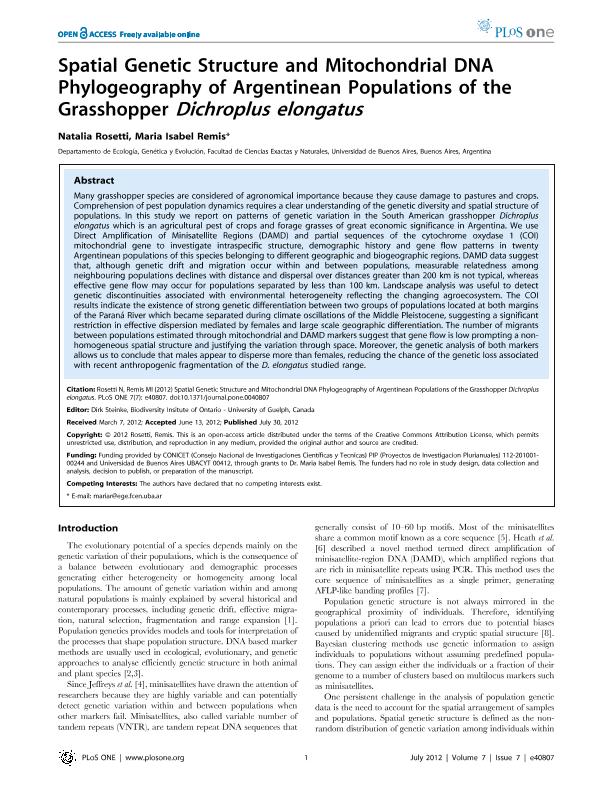Mostrar el registro sencillo del ítem
dc.contributor.author
Rosetti, Maria Eva Natalia

dc.contributor.author
Remis, Maria Isabel

dc.date.available
2019-01-16T20:16:50Z
dc.date.issued
2012-07
dc.identifier.citation
Rosetti, Maria Eva Natalia; Remis, Maria Isabel; Spatial genetic structure and mitochondrial DNA phylogeography of Argentinean populations of the Grasshopper dichroplus elongatus; Public Library of Science; Plos One; 7; 7; 7-2012; 1-20; e40807
dc.identifier.issn
1932-6203
dc.identifier.uri
http://hdl.handle.net/11336/68163
dc.description.abstract
Many grasshopper species are considered of agronomical importance because they cause damage to pastures and crops. Comprehension of pest population dynamics requires a clear understanding of the genetic diversity and spatial structure of populations. In this study we report on patterns of genetic variation in the South American grasshopper Dichroplus elongatus which is an agricultural pest of crops and forage grasses of great economic significance in Argentina. We use Direct Amplification of Minisatellite Regions (DAMD) and partial sequences of the cytochrome oxydase 1 (COI) mitochondrial gene to investigate intraspecific structure, demographic history and gene flow patterns in twenty Argentinean populations of this species belonging to different geographic and biogeographic regions. DAMD data suggest that, although genetic drift and migration occur within and between populations, measurable relatedness among neighbouring populations declines with distance and dispersal over distances greater than 200 km is not typical, whereas effective gene flow may occur for populations separated by less than 100 km. Landscape analysis was useful to detect genetic discontinuities associated with environmental heterogeneity reflecting the changing agroecosystem. The COI results indicate the existence of strong genetic differentiation between two groups of populations located at both margins of the Paraná River which became separated during climate oscillations of the Middle Pleistocene, suggesting a significant restriction in effective dispersion mediated by females and large scale geographic differentiation. The number of migrants between populations estimated through mitochondrial and DAMD markers suggest that gene flow is low prompting a non-homogeneous spatial structure and justifying the variation through space. Moreover, the genetic analysis of both markers allows us to conclude that males appear to disperse more than females, reducing the chance of the genetic loss associated with recent anthropogenic fragmentation of the D. elongatus studied range.
dc.format
application/pdf
dc.language.iso
eng
dc.publisher
Public Library of Science

dc.rights
info:eu-repo/semantics/openAccess
dc.rights.uri
https://creativecommons.org/licenses/by-nc-sa/2.5/ar/
dc.subject
Orthoptera
dc.subject
Mt Dna Variation
dc.subject
Minisatellites
dc.subject
Spatial Structure
dc.subject.classification
Otras Ciencias Biológicas

dc.subject.classification
Ciencias Biológicas

dc.subject.classification
CIENCIAS NATURALES Y EXACTAS

dc.title
Spatial genetic structure and mitochondrial DNA phylogeography of Argentinean populations of the Grasshopper dichroplus elongatus
dc.type
info:eu-repo/semantics/article
dc.type
info:ar-repo/semantics/artículo
dc.type
info:eu-repo/semantics/publishedVersion
dc.date.updated
2019-01-16T18:17:37Z
dc.journal.volume
7
dc.journal.number
7
dc.journal.pagination
1-20; e40807
dc.journal.pais
Estados Unidos

dc.journal.ciudad
San Francisco
dc.description.fil
Fil: Rosetti, Maria Eva Natalia. Universidad de Buenos Aires. Facultad de Ciencias Exactas y Naturales. Departamento de Ecología, Genética y Evolución. Laboratorio de Genética de la Estructura Poblacional; Argentina. Consejo Nacional de Investigaciones Científicas y Técnicas; Argentina
dc.description.fil
Fil: Remis, Maria Isabel. Universidad de Buenos Aires. Facultad de Ciencias Exactas y Naturales. Departamento de Ecología, Genética y Evolución. Laboratorio de Genética de la Estructura Poblacional; Argentina. Consejo Nacional de Investigaciones Científicas y Técnicas; Argentina
dc.journal.title
Plos One

dc.relation.alternativeid
info:eu-repo/semantics/altIdentifier/doi/http://dx.doi.org/10.1371/journal.pone.0040807
dc.relation.alternativeid
info:eu-repo/semantics/altIdentifier/url/https://journals.plos.org/plosone/article?id=10.1371/journal.pone.0040807
Archivos asociados
